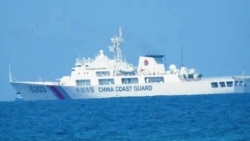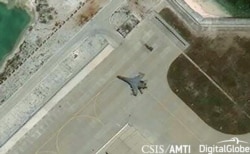On April 20, Philippines President Rodrigo Duterte said his hands were tied when it came to asserting the country’s rights in the West Philippine Sea — an eastern area of the South China Sea that China claims.
Duterte warned that any attempts by the Philippines to exercise its claims over the disputed territory would lead to conflict.
“We cannot do anything, just war. If we promote a war between China and American, we can, that's easy. But at what cost to us? That's the problem,” he said.
Also on April 20, Chinese Foreign Ministry Spokesperson Hua Chunying sent out a tweet proclaiming China’s peaceful ambitions on the world stage.
“However strong it may grow, #China will never seek hegemony, expansion, or a sphere of influence. Nor will China ever engage in an arms race,” Hua said.
That is false. In fact, China has flouted international rulings safeguarding the rights of neighbors in the South China Sea region.
In January 2013, the Philippines initiated a claim against the People’s Republic of China under Annex VII to the United Nations Convention on the Law of the Sea, which covers “the role of historic rights and the source of maritime entitlements in the South China Sea.”
The petition, filed with the Arbitral Tribunal at the Permanent Court of Arbitration in The Hague, contended that China’s claims to the bulk of the South China Sea, demarcated by the so-called nine-dash line, violated the Philippines’ rights to its Exclusive Economic Zone (EEZ) and territorial waters.
The U.N. Convention on the Law of the Sea recognizes the 200-nautical mile stretch of sea from the coast of a state as its EEZ.
Unlike territorial waters, the surface waters of the EEZ are international waters. A state, however, is allowed to explore, exploit, conserve and manage natural resources below the surface of the water and within the seabed of its EEZ.
In 2009, China claimed it had “indisputable sovereignty over the islands in the South China Sea and the adjacent waters, and enjoys sovereign rights and jurisdiction over the relevant waters as well as the seabed and subsoil thereof.”
In its July 2016 ruling, The Hague rebuked China’s sweeping claims to the sea. The ruling made clear that states are entitled to operate within their EEZs. The court, however, did not rule on issues of territorial sovereignty or maritime boundaries in the South China Sea.
China declared the ruling invalid. Since then, Beijing has become more assertive in the region.
According to the Asia Maritime Transparency Initiative (AMTI), conceived of and designed by the Center for Strategic and International Studies (CSIS), a Washington D.C.-based think tank, China has established 7 outposts in the Spratly Islands, an archipelago in the South China Sea off the coasts of Malaysia, the Philippines and Vietnam.
China also seized the Scarborough Shoal, approximately 137 miles east of the Philippines’ island of Luzon. China’s military blockade of the shoal is illegal under the Hague’s 2016 ruling.
In March, the Philippines’ Department of Foreign Affairs intensified demands that China withdraw dozens of so-called “Maritime Militia” ships “moored, anchored and stationary at Julian Felipe Reef,” in the Spratly Islands and the Philippines’ EEZ, Radio Free Asia reported.
Beijing also has 20 outposts in the Paracel Islands, claimed by China, Vietnam and Taiwan. The AMTI said three of these harbors are “capable of hosting large numbers of naval and civilian vessels.”
According to a 2020 U.S. Defense Department report, China “has deployed anti-ship cruise missiles and long-range surface-to-air missiles to the Spratly Islands, and fighters and SAMs to the disputed Paracel Islands.”
The AMTI argues that China’s military buildup on the Paracel and Spratly islands, including the creation of artificial islands, is key to “China’s goal of establishing surveillance and power projection capabilities throughout the South China Sea.”
Beijing’s power projection has included hostile actions towards China’s neighbors.
For example, China has repeatedly sunk Vietnamese fishing boats near the Paracel Islands and reportedly used the threat of force to halt Vietnamese drilling projects that fall within the nine-dash line.
Chinese vessels have also reportedly engaged in standoffs with Malaysian ships operating within Malaysia’s EEZ.
Although the U.S. claims neutrality on the territorial disputes, in July 2020 the administration of then-President Donald Trump called Beijing’s claims to offshore resources throughout most of the sea “completely unlawful,” condemning “its campaign of bullying to control them.”
President Joe Biden’s administration appears to be continuing that policy.
In January, China passed a bill granting its coast guard the right to fire on ships in disputed waters, inspect ships in Chinese-claimed waters and destroy structures on Chinese claimed reefs, Reuters reported.
In February, the Voice of America reported that China will use the law to target neighbors with competing maritime claims. Brunei, China, Malaysia, the Philippines, Taiwan and Vietnam all maintain claims to areas of the South China Sea.
A study by CSIS’s ChinaPower Project estimates that one-third of global shipping passes through the South China Sea, which is also rich in oil, gas, minerals and fisheries.
China claims it is “safeguarding its peace and stability in the region” and that the United States is attempting to drive a wedge between regional states.
Japan has accused China of attempting to unilaterally change the status quo through intensified military activity in the East China Sea, particularly around the disputed Senkaku/Diaoyu Islands.








